The Supremacy of Japanese Knives in Culinary Arts
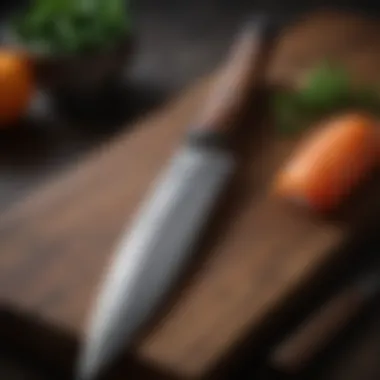

Intro
When it comes to culinary excellence, the tools chefs use can often be just as important as the ingredients themselves. Among these tools, Japanese knives hold a special place, renowned for their craftsmanship, precision, and rich history. The exceptional quality of these knives transcends mere aesthetics; they are designed not just for efficiency but also for a harmonious relationship with the user, making each cut a blend of skill and art.
Japanese knives are not just instruments; they embody a tradition that stretches back centuries. From the tools of ancient sushi chefs to the modern culinary artist's preferred choice, these knives have evolved, bringing together age-old techniques and contemporary needs. As we delve deeper, we discover the various forms these knives take, their particular uses, and what sets them apart from their Western counterparts. This exploration aims to give both seasoned chefs and food enthusiasts an appreciation of why Japanese knives reign supreme in the world of culinary arts.
While many may think a knife is just a knife, those who appreciate the subtle differences know there's much more involved. The type of steel, the shape of the blade, and even the balance in hand all contribute to a knife's unique identity. Plus, the joy of using a well-crafted knife resonates with the heart of cooking itself—the reverence for the ingredients and the respect for the process.
This journey will encompass the history behind these kitchen masterpieces, their distinctive types, and crucial tips on maintenance and care. Ultimately, you will glean insights that affirm the sentimental and practical value of Japanese knives in kitchens around the globe.
The Cultural Heritage of Japanese Knives
The realm of Japanese knives is steeped in a rich tapestry of history, artistry, and culinary significance. These blades are not merely tools for cutting; they embody centuries of tradition and cultural pride that reflect the craftsmanship of their makers. Understanding the cultural heritage behind Japanese knives enables one to appreciate the philosophy of cooking that is intricately intertwined with their design and use. The reverence for these tools by chefs and home cooks alike informs us of their status in the culinary world, making their exploration all the more compelling.
Historical Context
Origins of Japanese blade-making
The origins of Japanese blade-making can be traced back to ancient times, with methods influenced by the transition from iron to steel. Early swordsmiths in Japan began to experiment with different materials and techniques, leading to distinctive forms of blades. In those days, it wasn't simply about making a knife; it was an expression of identity and purpose. The high-carbon steel used in crafting knives is a hallmark of this tradition, encouraging precise cuts. This material contributes to a sharper edge and better durability, resonating with the demands of both professional and domestic cooks.
Another important aspect is the folding process of steel—often compared to the forging of a katana. The result is not only an aesthetically pleasing blade, but one that exhibits tremendous resilience and cutting power. This emphasis on quality and function is what makes knives like the Gyuto an enduring favorite among chefs. Its craftsmanship marks it as an exemplary choice for anyone seeking exceptional performance in their kitchen.
Influences from samurai culture
Influences from samurai culture play a significant role in the lineage of Japanese knives. The craftsmanship of blades has long been tied to the heritage of the samurai, where mastery of the sword was not just skill but an art. Samurai developed a profound respect for their weapons. This mindset translated into the art of knife-making, where the pursuit of perfection and functionality became paramount.
The samurai philosophy instilled an appreciation for the importance of balance, weight, and cutting efficiency in blade design. The Yanagiba, for instance, is specifically crafted for slicing fish, reflecting its samurai roots. Thus, these culinary tools take on a deeper meaning; they become extensions of individuality for their users. This influence from samurai tradition enriches the narrative around Japanese knives, making them not just tools, but keepers of a culture.
Craftsmanship Traditions
Artisanal skills and techniques
Artisanal skills and techniques are at the heart of Japanese knife production. Each knife is often handcrafted by skilled artisans who dedicate years to honing their craft. From choosing the right steel to perfecting the edge, these makers are not only skilled but are also storytellers, passing down their techniques through generations. This precision, combined with a deep-seated philosophy of craftsmanship, results in knives that are not only functional but also works of art.
One of the unique features of artisanal knife-making is the focus on the "Honsanmai" technique, where a hard steel core is enveloped by softer steel. This layering produces an incredibly sharp edge while providing durability. Such intricate techniques underscore why Japanese knives remain a sought-after choice in culinary arts, offering both beauty and superior performance.
Modern adaptations of traditional tools
Despite their long-standing history, Japanese knives have not stood still. Modern adaptations of traditional tools have emerged, blending time-honored techniques with contemporary needs. For instance, manufacturers are now experimenting with different metals and coatings that enhance corrosion resistance while keeping the integrity of the blade intact. This evolution reflects the knife industry's responsiveness to the demands of modern cooking.
As culinary contexts evolve with global influences, so too do the designs of Japanese knives. The integration of ergonomic handles provides better usability, catering to a broader audience from professional chefs to enthusiastic home cooks. Yet, the core of these adaptations retains a commitment to quality that makes them revered. This balancing act between tradition and innovation is central to the ongoing appeal of Japanese knives in today’s kitchens.
Understanding Japanese Knife Types
When one delves into the world of culinary tools, it quickly becomes clear that the type of knife in hand can profoundly impact cooking outcomes. Japanese knives stand out not just for their sharpness but also for their diverse designs, each tailored for specific tasks. Understanding the various types of Japanese knives is essential for anyone who wants to appreciate the nuances of culinary arts. Different knives cater to unique purposes, offering chefs the precision and efficiency they need in the kitchen. This knowledge equips both professional cooks and home chefs with the insight to select the right tool for the job, thereby enhancing their culinary pursuits.
Essential Knife Varieties
Gyuto: The All-purpose Knife
The Gyuto knife is quite the workhorse in any kitchen. Regarded as the versatile counterpart to the Western chef's knife, the Gyuto is well-suited for a range of tasks—from chopping vegetables to slicing meats. Its design typically features a blade length ranging between 6 to 12 inches, providing ample room for maneuver without being cumbersome.
One key characteristic of the Gyuto is its thin yet durable blade, which allows effortless slicing with minimal pressure. The curved edge facilitates a fluid rocking motion, making it easy to chop herbs and dice onions. This makes it a preferred choice for both novice cooks and seasoned professionals.
The unique feature of the Gyuto is its agility; chefs find it nimble for intricate tasks yet substantial for heavy-duty cutting. However, it’s important to note that its thin blade, while beneficial for delicate tasks, may require more frequent sharpening compared to heavier knives. Overall, this knife balances efficiency with performance, cementing its status in the kitchen.
Deba: The Specialized Fish Knife
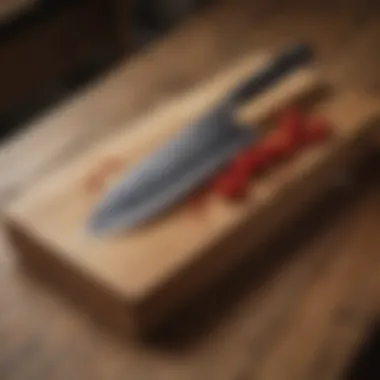
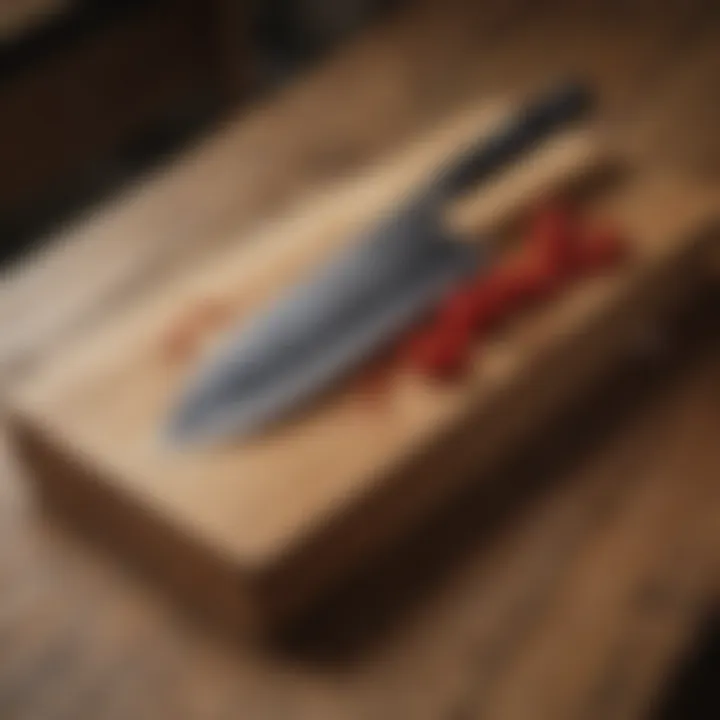
Focusing on a specific culinary need, the Deba knife shines particularly in filleting fish and poultry. Its stout, thick blade is generally between 5 to 9 inches, imparting considerable weight that excels in cutting through fish bones and tough skins without breaking a sweat.
The Deba is easily distinguishable with its single bevel edge, a crucial aspect that allows for cleaner cuts—ideal when working with delicate fish. This knife is cherished by sushi chefs for its ability to prepare slices without tearing the flesh. Such precision makes it a must-have for anyone serious about seafood preparation.
A unique feature of the Deba is its robust blade, which offers both advantages and disadvantages. While its solidity permits confident cuts, the single bevel may not be as versatile for various chopping tasks. In a traditional Sushi-ya, the Deba is seen as an indispensable tool, elevating the quality of the dishes prepared.
Yanagiba: The Slicing Blade
The Yanagiba knife, renowned for its elegant design, is primarily used for slicing sashimi and sushi. With a long, slender blade typically around 8 to 12 inches long, this knife is crafted to provide long, continuous cuts without dragging or tearing.
A pivotal characteristic of the Yanagiba is its ultra-sharp edge, often sharpened to a near-microscopic level, ensuring that fish and other proteins retain their texture and flavor during preparation. Chefs often praise this knife for allowing them to achieve ‘perfect cuts’—long slices that make presentation a centerpiece of the dining experience.
What sets the Yanagiba apart is its specialized design tailored for a specific task in high-stakes culinary settings. While it's fantastic for slicing, its narrower focus may limit its utility for broader kitchen duties like chopping or mincing. Nonetheless, for those who appreciate the art of sushi-making, the Yanagiba is nothing short of an essential tool.
Less Common Models
Usuba: The Vegetable Knife
Often overlooked by non-professionals, the Usuba is a traditional vegetable knife that embodies the essence of precision cutting in Japanese cuisine. Designed primarily for producing fine cuts of vegetables, it features a flat, thin blade that usually measures between 7 to 9 inches.
The key characteristic of the Usuba is its single bevel edge, similar to the Deba, which ensures extremely sharp, clean cuts necessary for achieving intricate garnishes. This knife excels in the hands of a skilled chef who values aesthetics in food presentation, as it allows for beautiful julienne strips and intricate vegetable carvings.
One uniqueness about the Usuba lies in its demanding skill requirements; mastering it often comes with a steep learning curve. For novice cooks, this may present a challenge as its accuracy necessitates a steady hand. Nevertheless, as chefs grow comfortable, the Usuba becomes a prized tool for creating visually stunning dishes.
Petty: The Utility Knife
In the broad spectrum of kitchen knives, the Petty knife serves a more specialized purpose. With a blade length ranging from 4 to 7 inches, it is a nimble utility knife that handles a variety of tasks with ease—ideal for paring, slicing, and intricate work.
The Petty's most significant attribute is its versatility; it can be applied to fruits, vegetables, and even delicate protein cuts. This adaptability makes it a fantastic choice in small kitchens or for chefs who appreciate having a lightweight tool that can tackle various cutting jobs.
However, while the Petty is efficient at many tasks, its lightweight blade can be less effective for heavier chopping or cutting through tough materials. It serves wonderfully as a complement to larger knives, making it an important element in a well-rounded knife collection.
Understanding the types of knives available is crucial for any culinary enthusiast, as each knife offers unique features that cater to different tasks. By recognizing the strengths and weaknesses of each type, cooks can elevate their skills and improve kitchen efficiency.
Comparative Analysis of Japanese and Western Knives
The juxtaposition of Japanese and Western knives brings to light significant differences that shape culinary practices globally. Understanding these distinctions is crucial for both aspiring chefs and home cooks who seek to refine their skills. By dissecting design elements and performance traits, learners can grasp how each knife's characteristics cater to different culinary needs and preferences.
Design and Aesthetics
Material selection and quality
When it comes to Japanese knives, the choice of materials often stands out. Typically crafted from high-carbon steel or specialty alloys, these materials offer remarkable edge retention and sharpness. This feature enhances the overall performance, making these knives a favorite in professional settings. The resilience of high-carbon steel, for instance, enables chefs to achieve precise cuts without frequent sharpening. However, one must be cautious as these materials can be more prone to rust if not properly cared for.
In contrast, Western knives usually use stainless steel. This material is favored for its durability and resistance to staining. While they may not hold an edge as long, their robustness makes them suitable for a variety of kitchen tasks. The characteristics of both materials contribute not only to the knife's longevity but also to the user’s overall experience in the kitchen.
Handling and balance differences
Another point where Japanese and Western knives diverge is in handling and balance. Japanese knives are often lighter, with a focus on finesse and precision. This design allows for a more agile cutting action, which can reduce fatigue during repetitive tasks. The balance tends to be more towards the blade, enhancing control when executing intricate cuts. This can be particularly beneficial for tasks such as delicate vegetable slicing or intricate meat preparations.
Western knives, meanwhile, generally have a heftier feel. The design prevails that weight allows for more power, suited for tougher ingredients. While they may provide a solid grip for heavier slicing or chopping tasks, the trade-off can be a decrease in agility. Whether a cook prefers one style over the other can significantly impact their own cooking efficiency and comfort.
Performance in Culinary Tasks
Cutting precision and control
Precision is a hallmark of quality kitchen tools, and here, Japanese knives shine markedly. The meticulous craftsmanship involved in the making of these knives often results in a remarkably sharp edge. This sharpness facilitates effortless slicing, benefiting tasks from cutting delicate fish to finely chopping herbs. The exactness afforded by a well-crafted blade contributes to the overall presentation of dishes, which is a core element of culinary art.
Conversely, Western knives may not slice with the same finesse but provide adequate performance for more robust culinary techniques. They tend to excel when more force is required, such as in cutting through heavier meats or vegetables. While one might argue that cutting precision leans in favor of Japanese styles, Western knives hold their ground in versatility when facing varied kitchen tasks.
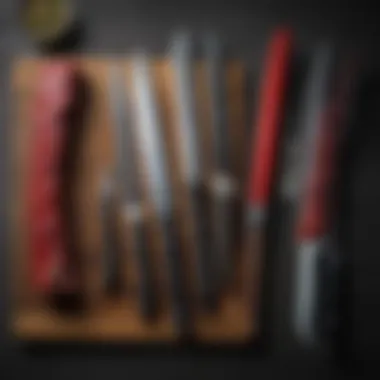
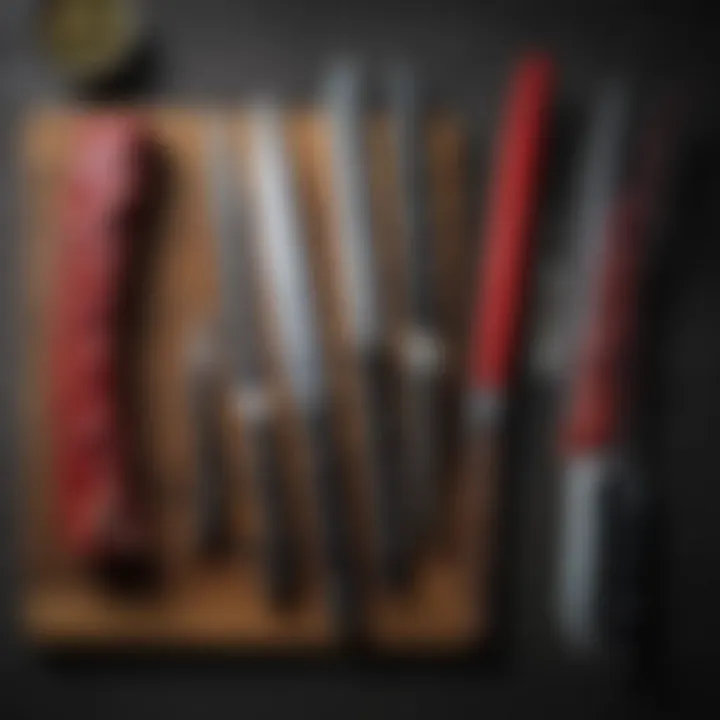
Durability in professional kitchens
In the demanding environment of professional kitchens, durability cannot be overstated. Japanese knives, with their meticulous craftsmanship, offer incredible sharpness and can remain effective much longer than many Western knives. However, this comes with the responsibility of care; regular maintenance is essential to prevent chipping or damage.
Western knives are built to endure the rigors of daily use, featuring sturdier designs to withstand the wear and tear of busy kitchens. While they might require more frequent sharpening to keep their edges, many chefs appreciate the reliable robustness they offer in a dynamic working environment. Therefore, each style presents its own set of advantages and disadvantages that can influence a culinary professional's choice depending on the setting and their personal preferences.
"Choosing between a Japanese and a Western knife boils down to personal style and the specific needs of the task at hand."
In summary, performing a comparative analysis of Japanese and Western knives unveils a richly nuanced understanding of their roles in the culinary arts. Whether you lean towards the precision of a Japanese knife or the sturdiness of Western variations, each has its place in a well-rounded culinary toolkit.
The Importance of Maintenance and Care
Caring for Japanese knives is akin to tending to a finely tuned instrument. These tools don’t just chop; they dance through ingredients, carving out culinary masterpieces. Therefore, ongoing maintenance is imperative, not just for the longevity of the blade but for the performance in the kitchen. A properly maintained knife can mean the difference between a mundane task and a delightful culinary experience. Let's explore how to keep these exquisite tools in top shape.
Sharpening Techniques
The key to maintaining a Japanese knife lies significantly in its sharpening. Regular sharpening not only preserves the sharp edge but improves the quality of the cuts as well. Two methods dominate the scene: using a whetstone or seeking professional services.
Whetstone methods and grits
Whetstones are often considered the gold standard for sharpening knives due to their versatility and effectiveness. They come in various grits, each serving a particular purpose. Generally, a coarser grit (like 240 or 400) is used for reshaping a dull blade, while finer grits (like 1000 and above) refine the edge for a razor-sharp finish.
- Key characterisitc: The control you have with a whetstone is unmatched. Instead of a one-size-fits-all approach, you can adjust the angle and pressure, honing in on what feels right for your specific knife.
- Unique feature: The process can feel meditative, giving you an opportunity to engage with your tools. Many enthusiasts find sharpening with a whetstone to be almost a form of art.
- Advantages: With a bit of practice, a user can maintain their knives effectively. It can also be quite economical compared to frequent visits to professionals.
- Disadvantages: This method requires time and a skilled hand. A few missteps can lead to a poor sharpening job, which is likely not ideal for those who lack patience or experience.
Professional sharpening services
For those who prefer a less hands-on approach, professional sharpening services provide a compelling alternative. Skilled artisans take your knives and bring them back to their original glory. This is especially beneficial for individuals who own multiple knives or those with high-end brands that may require more care.
- Key characterisitc: Professionals have an eye for detail. They can often spot issues that the average user might miss, ensuring a thorough job.
- Unique feature: Many services offer additional care, such as cleaning and minor repairs, which can enhance the lifespan of the knife.
- Advantages: This option guarantees a sharp edge, especially for those who may not feel comfortable sharpening their own knives. It also saves time for chefs with busy schedules.
- Disadvantages: Relying on professionals can become costly over time, especially if done frequently. Additionally, it may take time to turn around your knives, which is a hassle in pressing situations.
Storage Solutions
Proper storage is another cornerstone of knife care. How a knife is stored significantly impacts its longevity over time. The wrong choice can lead to dull blades or, worse, damage.
Knife blocks and magnetic strips
Store your knives with care in knife blocks or use magnetic strips.
- Key characterisitc: Knife blocks offer segmented slots for individual knives, which keeps them secure and helps prevent accidental damage to blades. Magnetic strips, on the other hand, allow for easy access and display, showcasing the artistry of the knives.
- Unique feature: Magnetic strips can free up counter space, as they mount to walls, keeping knives clear of clutter.
- Advantages: Both storage options protect the blade edges. Good storage solutions also ensure you're not rummaging through drawers to find the right knife, improving efficiency in your cooking.
- Disadvantages: Knife blocks take up counter space and may lead to some blades touching, risking chipping. Magnetic strips require careful placement on the wall to ensure they can hold heavier knives.
Protective sheaths and rolls
Alternatively, protective sheaths or rolls are highly effective for storing knives while on the go or during transport.
- Key characterisitc: Sheaths can be customized to fit specific blades, ensuring that they are guarded against damage. Rolls, typically made of durable fabric, can house multiple knives and allow chefs to transport their tools safely.
- Unique feature: They offer a functional and compact storage solution. It’s great for chefs on the move or for those who like to keep their collection tidy.
- Advantages: Both options keep blades shielded from damage, ensuring they aren't dull when needed. They can also promote organization, preventing any mix-ups with knives.
- Disadvantages: Depending on the sheath material, they can be cumbersome or take extra time to put on and off. Knife rolls, while practical, can lead to wear and tear if frequently packed.
Understanding and implementing maintenance and care techniques can vastly enhance the experience you have with Japanese knives. It’s not just about the initial investment in a high-quality blade, but also about how you look after it. With the right sharpening methods and thoughtful storage, your knives can become lifelong companions in the culinary journey.
User Experiences and Preferences
User experiences and preferences play a crucial role in appreciating the unique qualities of Japanese knives. These tools aren't just about functionality; they carry with them the weight of personal connection and cultural significance. When chefs and home cooks share their stories about using these blades, it offers valuable insight into their strengths and weaknesses, allowing potential buyers to make informed choices. Everyone has their own distinct style in the kitchen, which heavily influences their knife usage and preference.
Professional Chefs' Insights
Personal favorites and recommendations
It’s noteworthy how professional chefs often have particular knives that they swear by—like using a Miyabi Artisan for slicing delicate fish or a Masamoto gyuto for chopping vegetables. The chefs’ personal recommendations speak volumes about quality and functionality. A favorite knife can greatly enhance their cooking experience and efficiency.
One key characteristic of these favored knives is their sharpness and edge retention. This is why many chefs recommend brands like Takeda or Yoshihiro; their blades can be honed easily to a precision edge that lasts through heavy use in bustling kitchens. However, one downside is the cost, which can be prohibitive for some.
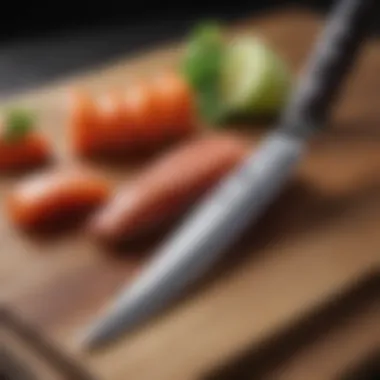
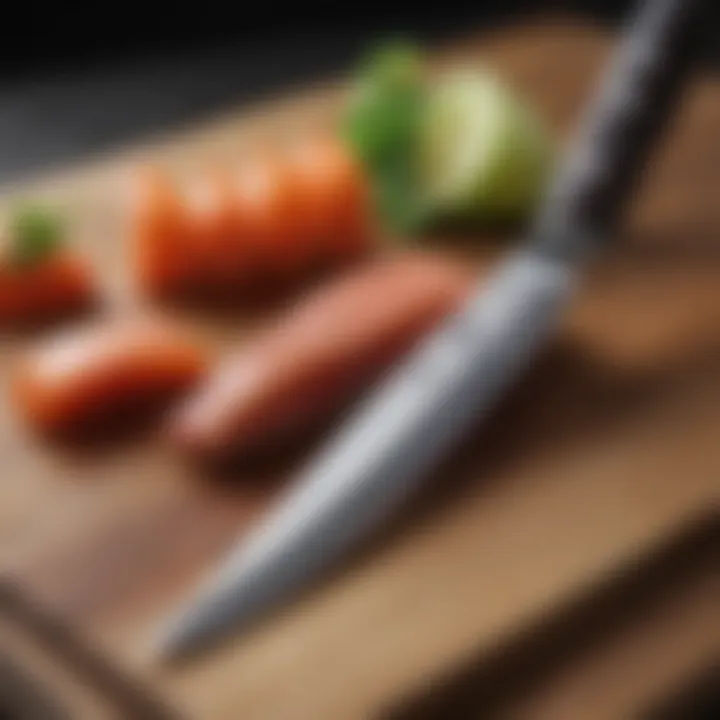
Impact on kitchen efficiency
Kitchen efficiency is a topic of great importance to any culinary professional. With the right knife, tasks that once felt cumbersome or time-consuming can be completed in no time. For instance, a well-balanced Santoku knife can make slicing herbs a breeze. The key characteristic here is the ergonomic design that provides a comfortable grip and allows for fluid motion.
This aspect makes Japanese knives not just tools but extensions of the chef’s hand, significantly improving productivity. However, not all users may feel comfortable adapting to the unique weight distribution of these knives initially. This learning curve can be a slight hurdle for those used to Western-style knives, where the feel in hand is typically more balanced toward the handle.
Home Cooks' Perspectives
Value for investment
When it comes to home cooks, the idea of value for investment regularly pops up in conversations. Many see Japanese knives as laughing investment rather than mere tools, understanding that proper care can result in decades of dependable service.
The relationship between the knife's craftsmanship and its longevity is quite evident among users. A high-quality knife, like those from Shun or Tojiro, may cost more upfront, but its performance can justify the price tag over years of use.
On the flip side, the initial investment may seem daunting to novice cooks who are still trying to master their skills. The unique feature here is that while the initial investment is substantial, the long-term benefits often outweigh the upfront costs.
Learning curve and adaptability
The learning curve associated with using Japanese knives does not deter many home cooks; rather, it often enriches their culinary journey. Cooks often find themselves engaging more deeply with their food when they use tools that demand a little more finesse. Learning to use a deba knife effectively might initially seem challenging, but the personal growth and newly acquired skills make it worthwhile.
An added advantage of this engagement is the sense of satisfaction that comes when mastering difficult cutting techniques. However, some users may get frustrated, particularly if they don’t get immediate results. Understanding how to maintain the edge and respect the proper cutting methods takes time, but makes cooking enjoyable.
"The right knife can change how you interact with food in the kitchen; it becomes a personally tailored tool, each slice infused with care."
Culinary Trends and Japanese Knives
Culinary trends are like the changing seasons—they evolve, sometimes swiftly, sometimes slowly, but they always bring something fresh to the table. In recent years, the appreciation for Japanese knives has surged among both home cooks and seasoned chefs. This is not just about the aesthetics or heritage; it's deeply intertwined with modern cooking practices and the culinary arts as a whole.
At the heart of this discussion lies the increasing popularity of diverse cooking styles. Japanese knives fit seamlessly into these evolving trends, offering both precision and versatility. They serve as an essential tool that complements various culinary techniques, elevating cooking experiences across the board.
Influence on Modern Cuisine
Fusion cooking and cross-cultural exchanges
Fusion cooking is the culinary equivalent of a melting pot, blending different styles and flavors from around the world. As chefs and home cooks alike venture into uncharted territories, Japanese knives have become pivotal in creating this hybrid cuisine. The main characteristic of fusion cuisine is its ability to merge distinct culinary traditions, often resulting in exciting new dishes. Using a well-crafted Japanese knife can make all the difference in achieving that finesse. For instance, slicing fresh sashimi to top on a traditional cheese tart requires precision—something Japanese knives deliver in spades.
The delicate design of these knives not only makes slicing an art, it also enhances the presentation, which is a critical aspect of modern dining. However, it’s essential to note that fusion cooking demands a respect for the original cultures. This balance of innovation and tradition can sometimes become a tightrope walk for chefs striving to push boundaries without losing authenticity.
Emerging food movements and preferences
The landscape of food is shifting towards healthier, more sustainable choices. Emerging food movements emphasize clean, fresh ingredients and often lean towards a plant-based approach. Japanese knives are indispensable in this realm; their efficiency in cutting and preparing vegetables is noteworthy. Chefs who adopt these cutting tools often find that they can create intricate vegetable presentations that appeal to the eye and the palate.
What sets these movements apart is their quest for transparency in sourcing ingredients. This has fostered a growing awareness among consumers of where their food comes from, and how it’s prepared. The unique aspect of these movements lies in their community focus, promoting local sources and environmentally friendly practices. This can sometimes pose a challenge, as not all Japanese knife techniques traditionally align with the ethics of modern eating.
Despite such hurdles, there is immense value in integrating Japanese knives into these new culinary developments. Their craftsmanship and performance can enhance the overall dining experience, fulfilling a dual role as tools and works of art.
Future Outlook
As we gaze into the future of culinary arts, it’s clear that Japanese knives will continue to hold their ground, evolving with trends and technologies.
Continued innovation in design and materials
The design and materials of Japanese knives are not static; they are in a state of continual innovation. New materials such as high-carbon stainless steel and novel manufacturing techniques are emerging, providing chefs with even sharper and more reliable tools. These advancements have led to knives that are not only beautiful but also incredibly functional.
The benefit of this innovation is twofold: chefs get the precision and control that the best culinary experiences demand, while manufacturers are also able to create products that require less maintenance. This continuous improvement matches the evolving needs of professional kitchens, where efficiency is key.
However, one must keep an eye on the balance. More commercialized products can stray from the artisanal craftsmanship that defines traditional Japanese knives.
Shifts in consumer demand and education
Consumer demands are evolving as well. Today’s shoppers are more informed and discerning. They seek products that solve problems while providing longevity and value. Japanese knives, with their reputation for quality and precision, are often at the forefront of this shift. Educating cooks, both novice and skilled, on the importance of proper handling and care ensures that these knives are not just tools, but valued companions in their culinary journey.
As educational platforms and culinary schools increasingly recognize the importance of these knives, more individuals are becoming adept at using them responsibly. This trend fosters a sense of responsibility towards quality cooking. However, the flip side is that becoming proficient with these knives can sometimes be challenging, especially for those used to heavier Western knives, which require a different handling technique.
In summation, the intersection of culinary trends and the realm of Japanese knives reflects a broader narrative of adaptation and tradition. The delicate balance of innovation, education, and respect for cultural authenticity will determine the future landscape of culinary arts.







